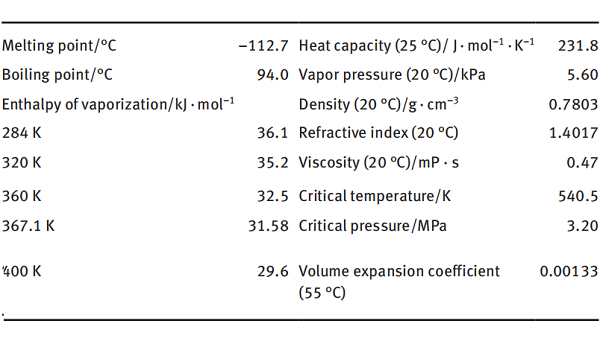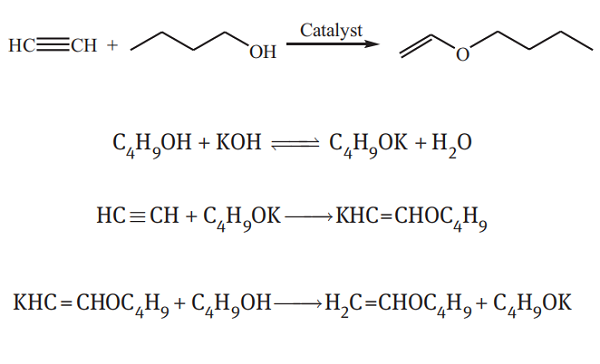The brief introduction of n-Butyl vinyl ether
Introduction
N-Butyl vinyl ether, abbreviated as BVE, is also known as butyl vinyl ether, butoxyethene, butyl vinyl ether, vinyl butyl ether, vinyl n-butyl ether, butoxyethylene, ethenyl n-butyl ether and 1-butoxyethylene. It is a monomer with high reactivity, exceptional quality, and good consistency. It is the best choice for a wide range of synthesis, including polymerization, addition, and electro-cyclic reactions. N-butyl vinyl ether can be used for polymerization, cross-linking monomers, and reactive diluents for UV curing.
Chemical properties
BVE is a colorless, transparent, and extremely flammable liquid. It is lachrymatory and irritates the respiratory system. BVE is miscible with various organic solvents such as benzene, diethyl ether, hexane, and carbon tetrachloride. The solubility of n-Butyl vinyl ether in water is 0.10% by weight, and water in BVE is 0.09% by weight at 20 °C.

The carbon–carbon double bond of this compound is chemically active due to the influence of an alkoxy group. It can undergo an addition reaction with a plurality of types of substances to form various derivatives. N-butyl vinyl ether does not undergo homogeneous polymerization alone, but it can be polymerized by a catalyst such as aluminum trichloride or boron trifluoride. It is stable to alkalis but readily hydrolyzes to form n-butanol and acetaldehyde under acidic conditions.
Synthesis method
BVE is produced by vinylation of n-butanol with acetylene in the presence of a catalyst. First, potassium hydroxide reacts with n-butanol to form alkoxide. Then, the alkoxide reacts with acetylene to obtain the potassium-substituted BVE. The potassium-substituted BVE reacts with n-butanol to generate BVE and alkoxide. The alkoxide continues to react with acetylene.

A superbase catalyst system CsF–NaOH–DMSO was developed to prepare BVE from acetylene and n-butanol at a temperature of 100 °C and under atmospheric pressure. After a reaction for 3.5 h, the conversion of n-butanol was 99%, and selectivity to isobutyl vinyl ether (IBVE) was 79%.
Uses
N-butyl vinyl ether is a monomer for homopolymerization and copolymerization to produce polyvinyl ethers, which are widely used in coatings, adhesives, additives, plasticizers, and viscosity index improvers.
Homopolymer of n-butyl vinyl ether
Poly(n-butyl vinyl ether) (PB) homopolymer is an oil-soluble chain polymer mainly used as a modifier of synthetic resin materials to improve aging resistance, gloss retention, wear resistance, antifouling, and so on. It is also a suitable plasticizer, ink additive, and viscosity index improver. Polymerization of BVE is carried out in the presence of an initiator such as stannous chloride, stannic chloride, aluminum chloride, and ferric chloride:
PB is used as the first viscosity index improver in China. The trademark is T-601. The viscosity index improver for lubricating oil products is mainly used for blending multigrade oil, improving the viscosity–temperature performance, low-temperature startability and pumpability, reducing the oil consumption and wear of engines, and is mainly used in internal combustion engine oil, hydraulic oil, automatic transmission fluid, and gear oil. PB is a light yellow viscous liquid with a relative molecular weight of 9,000–12,000. The product can increase the viscosity of lubricating oil and improve the viscosity–temperature performance to meet the general requirements of oil products in winter and summer. T-601 has good shear stability and low-temperature performance, but its thickening ability is not strong, and its thermal stability is not high.
The copolymer of n-butyl vinyl ether and other monomers
BVE can be copolymerized well with other monomers, leading to some polymer materials with excellent properties. For example, BVE is copolymerized with chlorotrifluoroethylene to produce a fluorocarbon coating with excellent properties. Room-temperature-curing fluorocarbon coating is a branch of fluorocarbon coatings that is widely used and rapidly developed. It is usually prepared by solution polymerization of fluorine-containing monomers (chlorotrifluoroethylene or vinylidene fluoride), vinyl ether (ester), hydroxyl vinyl ether, and other functional monomers. The regular alternating structure between monomers will give the final paint film excellent comprehensive properties.
You may like
See also
Lastest Price from n-Butyl vinyl ether manufacturers

US $1.00/PCS2025-06-27
- CAS:
- 111-34-2
- Min. Order:
- 1PCS
- Purity:
- 99%
- Supply Ability:
- 10 mt

US $0.00/kg2025-03-26
- CAS:
- 111-34-2
- Min. Order:
- 150kg
- Purity:
- 99%
- Supply Ability:
- 20 tons


